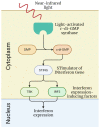Practical Use of Immortalized Cells in Medicine: Current Advances and Future Perspectives
- PMID: 37628897
- PMCID: PMC10454025
- DOI: 10.3390/ijms241612716
Practical Use of Immortalized Cells in Medicine: Current Advances and Future Perspectives
Abstract
In modern science, immortalized cells are not only a convenient tool in fundamental research, but they are also increasingly used in practical medicine. This happens due to their advantages compared to the primary cells, such as the possibility to produce larger amounts of cells and to use them for longer periods of time, the convenience of genetic modification, the absence of donor-to-donor variability when comparing the results of different experiments, etc. On the other hand, immortalization comes with drawbacks: possibilities of malignant transformation and/or major phenotype change due to genetic modification itself or upon long-term cultivation appear. At first glance, such issues are huge hurdles in the way of immortalized cells translation into medicine. However, there are certain ways to overcome such barriers that we describe in this review. We determined four major areas of usage of immortalized cells for practical medicinal purposes, and each has its own means to negate the drawbacks associated with immortalization. Moreover, here we describe specific fields of application of immortalized cells in which these problems are of much lesser concern, for example, in some cases where the possibility of malignant growth is not there at all. In general, we can conclude that immortalized cells have their niches in certain areas of practical medicine where they can successfully compete with other therapeutic approaches, and more preclinical and clinical trials with them should be expected.
Keywords: immortalized cells; regenerative medicine; tissue engineering.
Conflict of interest statement
The authors declare no conflict of interest.
Figures




Similar articles
-
The future of Cochrane Neonatal.Early Hum Dev. 2020 Nov;150:105191. doi: 10.1016/j.earlhumdev.2020.105191. Epub 2020 Sep 12. Early Hum Dev. 2020. PMID: 33036834
-
A prospect of cell immortalization combined with matrix microenvironmental optimization strategy for tissue engineering and regeneration.Cell Biosci. 2019 Jan 5;9:7. doi: 10.1186/s13578-018-0264-9. eCollection 2019. Cell Biosci. 2019. PMID: 30627420 Free PMC article. Review.
-
Immortalized cell lines derived from dental/odontogenic tissue.Cell Tissue Res. 2023 Jul;393(1):1-15. doi: 10.1007/s00441-023-03767-5. Epub 2023 Apr 11. Cell Tissue Res. 2023. PMID: 37039940 Review.
-
A methylation profile of in vitro immortalized human cell lines.Int J Oncol. 2005 Jan;26(1):275-85. Int J Oncol. 2005. PMID: 15586250
-
Chronoastrobiology: proposal, nine conferences, heliogeomagnetics, transyears, near-weeks, near-decades, phylogenetic and ontogenetic memories.Biomed Pharmacother. 2004 Oct;58 Suppl 1:S150-87. doi: 10.1016/s0753-3322(04)80025-8. Biomed Pharmacother. 2004. PMID: 15754855
Cited by
-
Insights into human muscle biology from human primary skeletal muscle cell culture.J Muscle Res Cell Motil. 2025 May 10. doi: 10.1007/s10974-025-09696-w. Online ahead of print. J Muscle Res Cell Motil. 2025. PMID: 40346328 Review.
-
Optimization of a human induced pluripotent stem cell-derived sensory neuron model for the in vitro evaluation of taxane-induced neurotoxicity.Sci Rep. 2024 Aug 17;14(1):19075. doi: 10.1038/s41598-024-69280-z. Sci Rep. 2024. PMID: 39154055 Free PMC article.
-
The roles of patient-derived xenograft models and artificial intelligence toward precision medicine.MedComm (2020). 2024 Sep 25;5(10):e745. doi: 10.1002/mco2.745. eCollection 2024 Oct. MedComm (2020). 2024. PMID: 39329017 Free PMC article. Review.
-
Immortalization of Mesenchymal Stem Cells for Application in Regenerative Medicine and Their Potential Risks of Tumorigenesis.Int J Mol Sci. 2024 Dec 18;25(24):13562. doi: 10.3390/ijms252413562. Int J Mol Sci. 2024. PMID: 39769322 Free PMC article. Review.
-
Macrophage variants in laboratory research: most are well done, but some are RAW.Front Cell Infect Microbiol. 2024 Oct 9;14:1457323. doi: 10.3389/fcimb.2024.1457323. eCollection 2024. Front Cell Infect Microbiol. 2024. PMID: 39445217 Free PMC article. Review.
References
-
- Kedong S., Xiubo F., Tianqing L., Macedo H.M., LiLi J., Meiyun F., Fangxin S., Xuehu M., Zhanfeng C. Simultaneous Expansion and Harvest of Hematopoietic Stem Cells and Mesenchymal Stem Cells Derived from Umbilical Cord Blood. J. Mater. Sci. Mater. Med. 2010;21:3183–3193. doi: 10.1007/s10856-010-4167-5. - DOI - PubMed
-
- Al-Nbaheen M., Vishnubalaji R., Ali D., Bouslimi A., Al-Jassir F., Megges M., Prigione A., Adjaye J., Kassem M., Aldahmash A. Human Stromal (Mesenchymal) Stem Cells from Bone Marrow, Adipose Tissue and Skin Exhibit Differences in Molecular Phenotype and Differentiation Potential. Stem Cell Rev. Rep. 2013;9:32–43. doi: 10.1007/s12015-012-9365-8. - DOI - PMC - PubMed
Publication types
MeSH terms
Grants and funding
LinkOut - more resources
Full Text Sources

